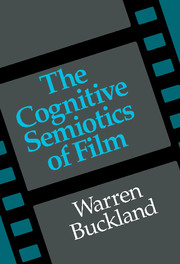Book contents
- Frontmatter
- Contents
- Preface and Acknowledgements
- 1 The Cognitive Turn in Film Theory
- 2 The Body on Screen and in Frame: Film and Cognitive Semantics
- 3 Not What Is Seen through the Window but the Window Itself: Reflexivity, Enunciation, and Film
- 4 The Institutional Context: A Semio-pragmatic Approach to Fiction and Documentary Film
- 5 All in the Mind? The Cognitive Status of Film Grammar
- Conclusion
- Notes
- Bibliography of Works Cited
- Index
2 - The Body on Screen and in Frame: Film and Cognitive Semantics
Published online by Cambridge University Press: 02 December 2009
- Frontmatter
- Contents
- Preface and Acknowledgements
- 1 The Cognitive Turn in Film Theory
- 2 The Body on Screen and in Frame: Film and Cognitive Semantics
- 3 Not What Is Seen through the Window but the Window Itself: Reflexivity, Enunciation, and Film
- 4 The Institutional Context: A Semio-pragmatic Approach to Fiction and Documentary Film
- 5 All in the Mind? The Cognitive Status of Film Grammar
- Conclusion
- Notes
- Bibliography of Works Cited
- Index
Summary
Reason is embodied in the sense that the very structures on which reason is based emerge from our bodily experiences. Reason is imaginative in the sense that it makes use of metonymies, metaphors, and a wide variety of image schemas.
(George Lakoff).Modern (or ‘contemporary’) film theory marks a decisive break with the classical film theory of Rudolf Arnheim, André Bazin, Bela Balàsz, Siegfried Kracauer, and Victor Perkins. We can characterize this break as a transition from an extensional semantic to an intensional (or immanent) semantic theory of meaning. Classical film theory is a theory of cinematic representation premised upon mechanical duplication (upon the existential relation between film and referent) and is therefore based upon an extensional semantic theory of meaning. In contrast, modern film theory, beginning with the film semiotics of Christian Metz, corresponds to an intensional semantic theory of meaning, for it drove a wedge between mechanical duplication and cinematic representation and then defined the latter, not externally – as the effect of an existential link between film and referent – but internally – as an effect of codes.
Furthermore, the evolution of modern film theory can be characterized as progressing from an intensional semantic to a pragmatic theory of filmic meaning. Pragmatists study how successful communication is achieved on the level of language use. This is because, they argue, language's meaning is not determined in advance of its use.
- Type
- Chapter
- Information
- The Cognitive Semiotics of Film , pp. 26 - 51Publisher: Cambridge University PressPrint publication year: 2000



